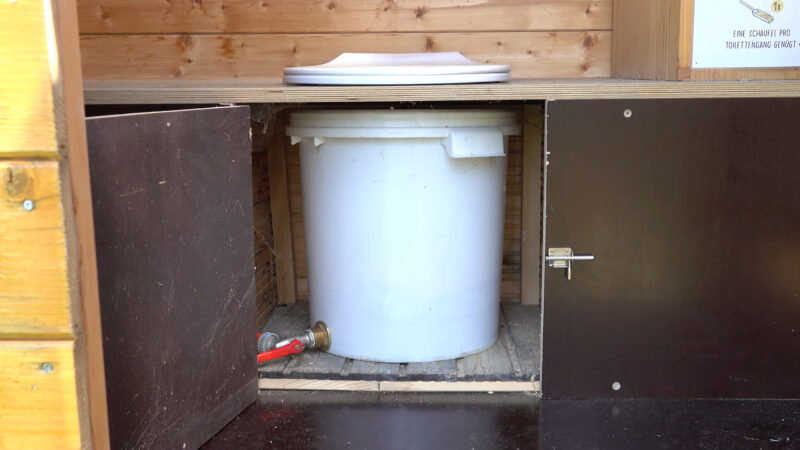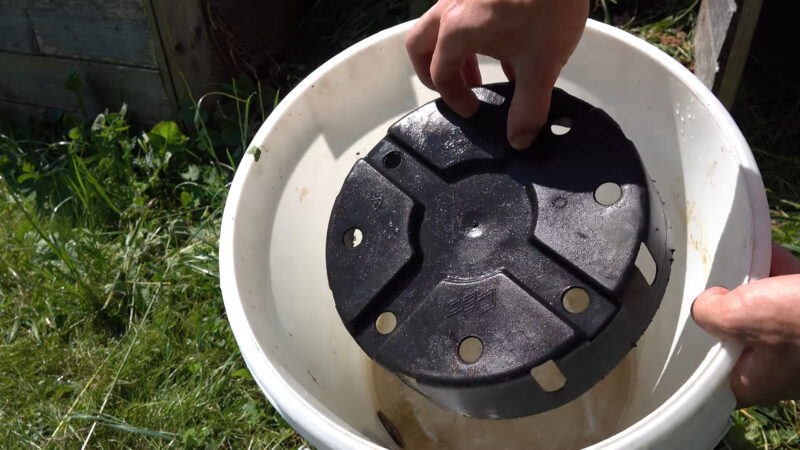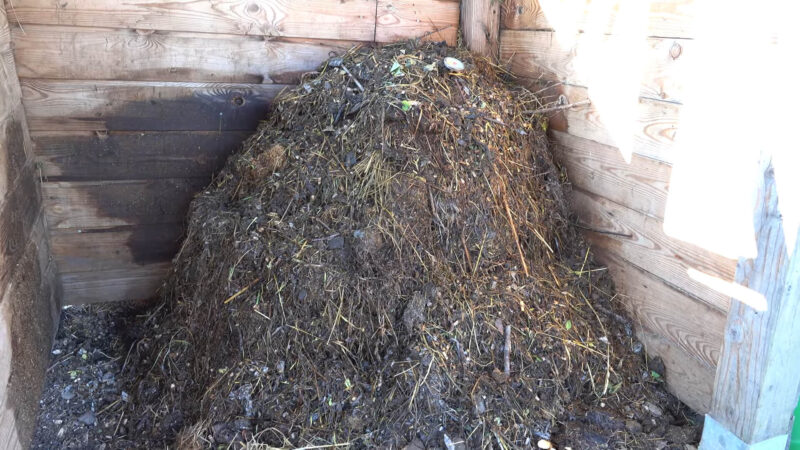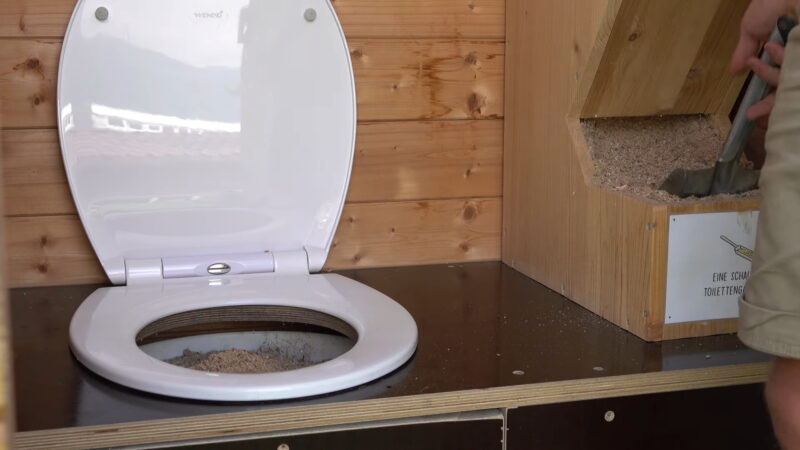I’ve dedicated my best efforts to understanding and promoting practices that contribute positively to our environment. One such practice that I find particularly fascinating and impactful is the use of compost toilets. Compost toilets represent a significant leap forward in our approach to sanitation.
They are not just toilets; they are a sustainable system that transforms human waste into valuable compost, all while conserving water and reducing our ecological footprint. What needs to be said is that these toilets are quite different from tumblers.
Today, I’m excited to share with you the intricate workings of compost toilets, a remarkable solution that not only addresses waste management issues but also contributes to the health of our planet. Without further ado, let us begin.
How Waste is Processed in a Compost Toilet
The procedure of waste processing in a compost toilet goes like this.
Aerobic Decomposition by Microorganisms
The core process in a compost toilet is aerobic decomposition, a natural and efficient method of breaking down organic matter. This process is facilitated by a diverse community of microorganisms, including bacteria, fungi, and actinomycetes.
These microorganisms require a balanced environment to efficiently convert human waste into compost. The balance involves the right mix of carbon and nitrogen: carbon comes from bulking agents like sawdust or coconut coir, while nitrogen is provided by the human waste itself.
Oxygen plays a critical role in this process, as aerobic bacteria need it to break down the waste effectively. The design of compost toilets, therefore, incorporates features to ensure a steady supply of air, either passively through vents or actively through mechanical means.
Moisture and Oxygen Needed for Composting
Moisture control is another vital aspect of the composting process. The ideal moisture content for composting is around 50-60%. If the moisture level is too high, it can lead to anaerobic conditions, which not only slow down the composting process but also produce unpleasant odors and potentially harmful byproducts.
On the other hand, if the compost is too dry, microbial activity diminishes, slowing down the decomposition process. Regular monitoring and adjustment of moisture levels are thus essential. This can be achieved by adding dry bulking materials to absorb excess moisture or by introducing moisture if the compost is too dry.
Oxygen is equally crucial; it supports the survival and activity of aerobic microorganisms. Proper ventilation and occasional turning of the compost ensure that oxygen is distributed evenly throughout the composting mass.
Of course, oxygen is also important for compost heap production while it is inside of a tumbler.
Heating Kills Pathogens in Waste
The heat generated during the aerobic decomposition process is a natural and effective means of pathogen reduction. As the microorganisms break down the waste, they generate heat, which can raise the temperature of the composting significantly.
To effectively kill pathogens, the compost should reach a temperature of at least 55°C (131°F) for a sustained period. This thermophilic (heat-loving) phase not only helps in sanitizing the compost but also accelerates the breakdown of complex organic compounds, including potential pharmaceutical residues.
The design of the compost toilet, including insulation and the size of the mass, can influence how well it retains and generates heat. In some advanced systems, temperature monitoring is incorporated to ensure that the composting process remains both efficient and hygienic.
The Basic Components of a Compost Toilet

To better understand the functionality and design of a compost toilet, it’s helpful to examine its basic components.
Each component plays a specific role in ensuring the efficient and hygienic processing of waste.
| Component | Description |
|---|---|
| Container to Collect Waste | The primary receptacle where waste is deposited. Engineered to facilitate the composting process, made from durable and easy-to-clean materials like plastic or metal. Sized based on expected waste output. |
| Ventilation System | Essential for reducing odors, aiding moisture evaporation, and providing oxygen to aerobic microorganisms. Ensures a healthy composting process and prevents harmful gas buildup. |
| Composting Medium | Materials like sawdust, coconut coir, or peat moss used to balance moisture levels and add carbon. Absorbs liquids, minimizes odors, and creates a conducive environment for microbes. |
| Leachate Collection System | Manages liquid byproduct (leachate) from the composting mass. Ensures leachate is reabsorbed, evaporated, or safely disposed of to prevent environmental contamination. |
| Access Door or Hatch | Allows for removal of finished compost and facilitates maintenance tasks like adding materials or inspecting the process. |
| Temperature Monitoring | Incorporated in some systems to ensure compost reaches sufficient heat for pathogen destruction, optimizing safety and efficiency. |
| Agitator or Turner | Used in some toilets to mix and aerate the compost, promoting even decomposition and preventing clump formation. |
| Urine Diverting System | Separates liquid waste from solid waste in systems where urine separation is desired, helping control moisture levels and providing a separate nutrient source. |
Maintenance Requirements
Of course, maintenance is required in the case of compost toilet. Regular addition of bulking materials like sawdust or straw is necessary to maintain the carbon-nitrogen balance and to help absorb excess moisture. This also aids in creating air pockets, which are essential for maintaining aerobic conditions.
Periodic stirring or turning of the compost helps to aerate the pile, ensuring even decomposition and preventing odor issues. This can be done manually or through mechanical means in more advanced systems. Once the composting process is complete, and the container is full, the compost needs to be removed.
Depending on the system, this compost can be used directly in gardens or may need to cure further in a secondary location.

Types of Composting Toilets
To better understand the different types of composting toilets and their specific characteristics.
| Type | Description | Best Suited For |
|---|---|---|
| Self-contained Unit | Composting occurs in the same unit as the toilet. These units are compact and do not require a separate composting site. | Smaller installations, such as individual homes, cabins, or small businesses. |
| Central Composting Unit | Waste is transported to a separate composting unit, often located away from the toilet itself. These systems can handle larger volumes of waste. | Larger installations like commercial buildings, parks, or community centers. |
| Batch Composting | Waste is added to a single container until full, then left to compost while a new container is used. This allows for distinct batches of compost to be processed. | Situations where waste can be segregated into batches, allowing for periods of composting and resting. |
| Continuous Composting | Allows for ongoing addition of waste and removal of compost, usually through a multi-chamber design. This system continuously processes waste. | High-usage areas or where continuous waste processing is needed. |
| Dry Composting Toilets | These toilets separate liquid and solid waste, often requiring no water for flushing. The solid waste is composted, while the liquid can be treated or used as fertilizer. | Areas with limited water resources or where water conservation is a priority. |
| Vermicomposting Toilets | Utilize worms in addition to microbes to break down waste. These systems are efficient and produce high-quality compost. | Environments where a faster, more efficient composting process is desired, and regular maintenance is feasible. |
This approach allows for a clearer comparison and understanding of each type. Composting toilets vary in design and functionality, catering to different needs and situations. Later, the compost can be kept in bins or tumblers.
Advantages of Compost Toilets
Now that you understand all the relevant factors, let us talk about the advantages.
Don’t Require Water or Sewer
One of the most significant advantages of compost toilets is that they do not require water or connection to a sewer system. This makes them ideal for remote locations, environmentally sensitive areas, and places where water is scarce.
Generate Usable Compost
Compost toilets transform human waste into compost, a nutrient-rich material that can be used to enrich soil. This not only recycles waste but also contributes to sustainable gardening and agriculture practices.
Environmentally Sustainable
By reducing water usage and preventing the pollution of waterways with sewage, compost toilets offer an environmentally sustainable alternative to traditional toilets. They close the loop in waste management, turning a waste product into a resource. It is one of the major advantages of this device.
Potential Drawbacks

As is the case with any concept, it also has drawbacks. Let us explore them.
Odor if Not Properly Maintained
If a compost toilet is not properly maintained, it can lead to odor issues. This is usually due to improper balance of moisture, lack of aeration, or inadequate addition of bulking materials.
Requires More Owner Maintenance
Compost toilets typically require more active involvement from the owner, including adding bulking materials, turning the compost, and emptying the finished compost. This can be a drawback for those accustomed to the convenience of traditional toilets.
May Require Permits in Some Areas
In some regions, the installation and use of compost toilets are subject to regulations, and permits may be required. This can add an additional layer of complexity to their adoption.
FAQs
Do you have to empty a composting toilet?
Yes, composting toilets need to be emptied periodically. The frequency depends on the size of the toilet and the number of users, but typically it ranges from a few weeks to several months. The process is rather similar to emptying composting tumblers or bins after the compost was in them for a certain period.
Where does the waste go in a composting toilet?
In a composting toilet, waste is deposited into a container or chamber where it undergoes composting. Over time, it breaks down into compost through natural processes aided by microorganisms, which can then be used as soil conditioner.
How do you wipe with a composting toilet?
You wipe in a composting toilet just as you would with a regular toilet. It’s recommended to use toilet paper that is easily biodegradable to aid the composting process. Some people opt for natural alternatives like bidets or washlets for a more sustainable approach.
Do composting toilets smell?
If maintained correctly, composting toilets should not emit any foul odors. Proper ventilation, regular emptying, and the correct balance of composting materials are key to controlling smells.
The Bottom Line
I hope this comprehensive overview of compost toilets has provided you with valuable insights into how these systems work and their significant benefits. Compost toilets are more than just an alternative to traditional toilets; they are a testament to our ability to live in harmony with nature.
By embracing such technologies, we take a step towards a more sustainable and environmentally conscious lifestyle.
Related Posts:
- Deforestation Killing the Lungs of The Planet: The…
- 12 Ways the Gambling Industry Can Shrink Its Carbon…
- What Does Squirrel Poop Look Like? - Warning-Contains Nuts
- How Many Stomachs Does a Cow Have? - Explained!
- What Sounds Does A Chipmunk Make: Study In Animal…
- What Does Frog Poop Look Like? - Analyzing the Appearance








